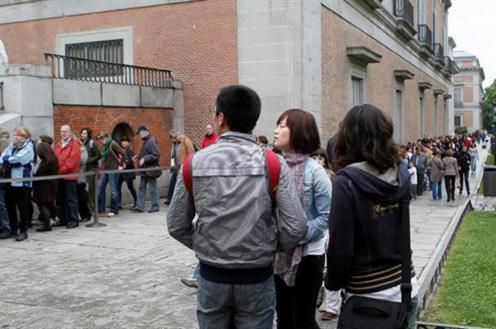Ana Botella presenta el proyecto de renovación de la torre, que incluye una visita guiada al mirador y un nuevo punto de información
• Se reabrirá a finales de marzo
• Visitantes y madrileños volverán a disfrutar de sus espectaculares vistas a 92 metros de altura, que permiten contemplar el skyline de Madrid
• El objetivo es convertir a este símbolo de la arquitectura madrileña en uno de los grandes iconos del turismo del destino Madrid y poner en valor la oferta de los espacios e instituciones culturales de su entorno
• El punto de atención permanecerá abierto los 365 días del año, de 9.30 a 20.30 horas, para ofrecer información sobre los atractivos y servicios turísticos de la capital
• La visita guiada al mirador, que estará dirigida por un guía profesional y cuya tarifa general será de 3 euros, podrá realizarse en español o inglés
"Hoy podemos decir ¡De Madrid al cielo! con este Faro de Moncloa que se alza sobre la ciudad para admirar su línea de horizonte, sus edificios históricos y singulares, sus zonas verdes y, por supuesto, su espectacular cielo". La alcaldesa de Madrid, Ana Botella, ha presentado hoy el proyecto de renovación del Faro de Moncloa, que reabrirá a finales de marzo y recupera uno de los principales miradores de la ciudad, esta antigua torre de iluminación construida en 1992 para conmemorar la designación de Madrid como Capital Europea de la Cultura.
Según Botella se trata de un "privilegiado mirador que se reincorpora a la ruta turística de los grandes miradores de Madrid para reforzar el atractivo de nuestra ciudad". Visitantes y madrileños volverán a disfrutar de unas espectaculares vistas panorámicas, a 92 metros de altura, que permiten contemplar desde el Cuartel General del Ejército de Moncloa hasta el Palacio Real, la Almudena, el edificio Telefónica de Gran Vía, las Cuatro Torres o la sierra de Guadarrama. "Este renovado Faro de Moncloa se convertirá, sin lugar a dudas, en un foco turístico fundamental para la capital... una experiencia más para hacer inolvidable su estancia en nuestra ciudad", según la alcaldesa.
Las novedades de la reapertura son una visita guiada al mirador y la ubicación de un nuevo punto de información al visitante en la base faro. El objetivo es convertir a este símbolo de la arquitectura madrileña en uno de los grandes iconos del turismo en Madrid y destacar algunos de los espacios e instituciones culturales de su entorno que, como el Museo de América o el Museo del Traje, no se incluyen en el circuito turístico tradicional pero dan un valor añadido a la oferta madrileña.
La alcaldesa de Madrid afirma estar segura de que "este renovado servicio turístico de Madrid será una de las atracciones más demandadas por nuestros visitantes nacionales e internacionales, que el año pasado, como saben, consolidaron a Madrid como el destino urbano más visitado de España, con un récord histórico de más 8,3 millones de viajeros".
Precisamente hoy se conocía un nuevo record de turistas en Madrid: enero se cierra con la llegada de 608.941 visitantes, que representa una subida interanual del 9,5%, y que marca un nuevo hito en la historia del turismo en la capital. "Es el primer mes de enero en que se supera la cifra de los 600.000 viajeros", ha dicho la alcaldesa. A estos datos hay que añadir el de las pernoctaciones, que durante el mes pasado experimentaron una subida de casi el 15% con más de 1,2 millones.
Visita guiada desde el cielo
El acceso al faro, que se realizará en grupos de un máximo de 10 personas, incluirá una visita guiada al mirador dirigida por un guía profesional y que podrá realizarse en español e inglés. Durante este pequeño recorrido, de unos 15 minutos de duración, se dará a conocer información de interés sobre la ciudad y curiosidades sobre sus puntos más visibles. Una vez finalizado, el público dispondrá de otros 15 minutos para contemplar las magníficas vistas, hacer fotografías y observar los paneles informativos sobre el skyline madrileño instalados en el mirador.
La tarifa general de acceso al mirador y la visita guiada tendrá un coste de 3 euros (1,50 euros para niños de entre 7 y 14 años, desempleados, mayores de 65 años y personas con discapacidad; gratis para niños de 0 a 6 años). Las entradas podrán adquirirse en el propio faro y en el Centro de Información Turística de la Casa de la Panadería. El horario para visitar el mirador será de 10 a 20 horas.
Nuevo punto de información turística
Este proyecto permitirá ampliar el servicio de atención e información turística que la ciudad de Madrid brinda a sus viajeros, gracias a la instalación de un punto informativo en la base del faro. Un espacio que se suma a los otros 10 centros y puntos con los que cuenta la ciudad: Plaza Mayor, Colón, CentroCentro, Cibeles, Paseo del Arte, aeropuerto (T2 y T4 en salas 10 y 11), unidad móvil y SATE.
Permanecerá abierto los 365 días del año, de 9.30 a 20.30 horas, ofrecerá información general sobre la ciudad de Madrid, su agenda de ocio, así como de los recursos turísticos del entorno del faro: el Museo de América, el Museo del Traje o el Real Jardín Botánico Alfonso XIII. Visitantes y ciudadanos también podrán informarse sobre el resto de productos y servicios que el Ayuntamiento de Madrid pone a su disposición, a través de la empresa municipal Madrid Destino, como su Programa de Visitas Guiadas Oficiales, su tarjeta turística Madrid Card o el autobús turístico Madrid City Tour./
DEPARTAMENTO DE COMUNICACIÓN
MADRID DESTINO
(AYUNTAMIENTO DE MADRID)
Plaza Mayor, 27 - 3ª planta
28012 (Madrid)
________________________________________________________
www.carsedan.es
_________________________________________________





.png)
